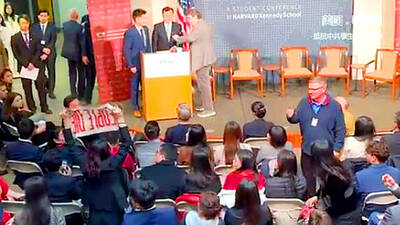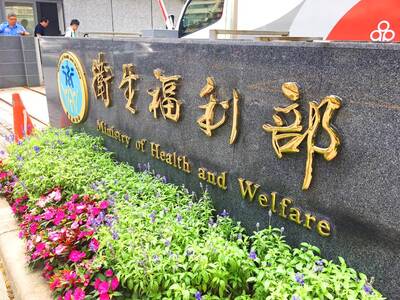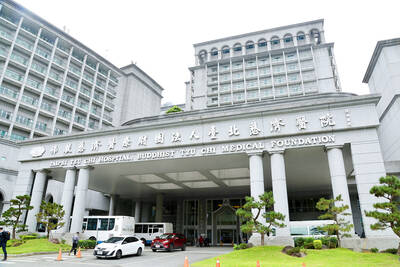Construction crews yesterday morning laid the first pier foundation for the Kinmen Bridge (金門大橋), the National Freeway Bureau said, adding that it is confident that the bridge would be finished by 2021.
The bridge would connect Greater Kinmen (大金門) and Lieyu (烈嶼, also known as Little Kinmen), the two main islands in the county, the bureau said.
It would span a strip of sea whose bed is on average 7m below the surface, it said, adding that in some areas the seabed is about 20m below the surface.
The geological complexity has made it impossible to lay the pier foundations using steel sheet piles, so the construction crews used the steel cofferdam method, the bureau said.
This was the first time the method was used by the bureau to lay a pier foundation, which took two months to complete, it said, adding that it should be able to lay the other pier foundations faster.
The bureau in March laid a foundation pile on granite.
The bureau yesterday explained the challenges of applying the steel cofferdam method.
The crews first installed jacketed steel pipes as a support base before beginning the construction, it said.
They assembled the steel cofferdam on land before lowering it to a designated depth using 12 large hydraulic jacks, the bureau said, adding that divers worked 3m to 9m below the sea surface to install bottom boards for the cofferdam and seal the plates between jacketed steel pipes.
Crews then pumped in concrete to form a 1.5m-thick bedding at the bottom of the cofferdam before pumping out the seawater trapped inside the structure, it said.
The cofferdam had to withstand buoyancy of more than 1,000 tonnes and tidal effects twice per day, the bureau said, adding that the crews installed six jacketed steel pipes and buoyancy-resistant steel piles to reinforce the structure.
Divers were kept on standby during the construction in case seawater leaked into the cofferdam, it said.
The bridge project has been criticized for “only surfacing during elections.”
The Legislative Yuan’s budget center has said in a report that the project had several issues, such as low budget implementation efficiency and construction delays.

A group of Taiwanese-American and Tibetan-American students at Harvard University on Saturday disrupted Chinese Ambassador to the US Xie Feng’s (謝鋒) speech at the school, accusing him of being responsible for numerous human rights violations. Four students — two Taiwanese Americans and two from Tibet — held up banners inside a conference hall where Xie was delivering a speech at the opening ceremony of the Harvard Kennedy School China Conference 2024. In a video clip provided by the Coalition of Students Resisting the CCP (Chinese Communist Party), Taiwanese-American Cosette Wu (吳亭樺) and Tibetan-American Tsering Yangchen are seen holding banners that together read:

UNAWARE: Many people sit for long hours every day and eat unhealthy foods, putting them at greater risk of developing one of the ‘three highs,’ an expert said More than 30 percent of adults aged 40 or older who underwent a government-funded health exam were unaware they had at least one of the “three highs” — high blood pressure, high blood lipids or high blood sugar, the Health Promotion Administration (HPA) said yesterday. Among adults aged 40 or older who said they did not have any of the “three highs” before taking the health exam, more than 30 percent were found to have at least one of them, Adult Preventive Health Examination Service data from 2022 showed. People with long-term medical conditions such as hypertension or diabetes usually do not

MEDICAL: The bills would also upgrade the status of the Ethical Guidelines Governing the Research of Human Embryos and Embryonic Stem Cell Research to law The Executive Yuan yesterday approved two bills to govern regenerative medicine that aim to boost development of the field. Taiwan would reach an important milestone in regenerative medicine development with passage of the regenerative medicine act and the regenerative medicine preparations ordinance, which would allow studies to proceed and treatments to be developed, Deputy Minister of Health and Welfare Victor Wang (王必勝) told reporters at a news conference after a Cabinet meeting. Regenerative treatments have been used for several conditions, including cancer — by regenerating blood cells — and restoring joint function in soft tissue, Wang said. The draft legislation requires regenerative treatments

POLICE INVESTIGATING: A man said he quit his job as a nurse at Taipei Tzu Chi Hospital as he had been ‘disgusted’ by the behavior of his colleagues A man yesterday morning wrote online that he had witnessed nurses taking photographs and touching anesthetized patients inappropriately in Taipei Tzu Chi Hospital’s operating theaters. The man surnamed Huang (黃) wrote on the Professional Technology Temple bulletin board that during his six-month stint as a nurse at the hospital, he had seen nurses taking pictures of patients, including of their private parts, after they were anesthetized. Some nurses had also touched patients inappropriately and children were among those photographed, he said. Huang said this “disgusted” him “so much” that “he felt the need to reveal these unethical acts in the operating theater